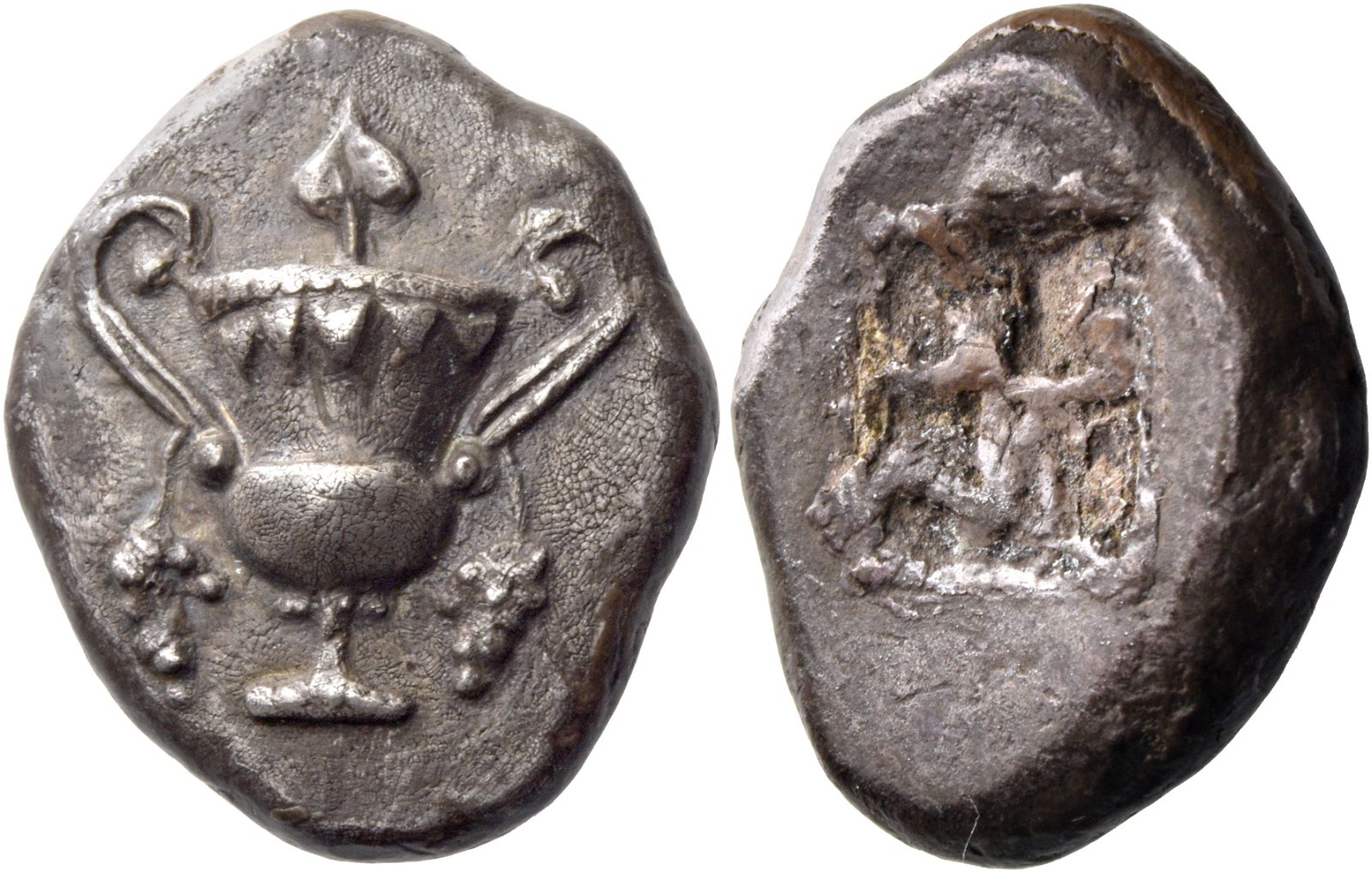Paros, silver, staters (cantharus/quadripartite incuse square) (530-515 BCE)
From SILVER
(Redirected from S 225 - Paros, silver, staters (530-515 BCE))
530 BCE - 515 BCE Silver 573 kg
Description
| ObverseInscription or printing placed on the obverse.: | Cantharus with ivy leaf finial on lid, grape bunches hanging from handles. |
| ReverseInscription or printing placed on the reverse.: | Quadripartite incuse square. |
Mint and issuing power
| MintIdentifies the place of manufacture or issue of a numismatic object.: | Paros | Ancient regionAncient region.: | Cyclades | Modern countryModern country: Greece | AuthorityIdentifies the issuing power. The authority can be "pretended" when the name or the portrait of X is on the coin but he/she was not the issuing power. It can also be "uncertain" when there is no mention of X on the coin but he/she was the issuing power according to the historical sources: |
Chronology
| FromIdentifies the initial date in a range assigned in a numismatic context. | 530 BCE | toIdentifies the final date in a range assigned in a numismatic context.. | 515 BCE | PeriodTime period of the numismatic object.: Archaic until 480 BC |
Physical description
| MetalThe physical material (usually metal) from which an object is made.: | Silver |
Median weightMedian of the weights of numismatic objects (in grams). in grams | 12.30 | DenominationTerm indicating the value of a numismatic object. Examples: tetradrachm, chalkous, denarius.: | stater |
StandardStandard.: |
Image

S 225 - Paros, silver, staters (530-515 BCE).jpg [1]
References
| Die study referencePublication of the study: | Sheedy 20061Sheedy 2006, p. 200-201, n° 1-2 | ||
| Coin series referenceReference to coin series study: | |||
| Coin series web referenceCoin series web references: | |||
Obverse dies distribution
| FrequencyFrequency of specimen in distribution. ᵖ | Number of obversesNumber of obverse dies. ᵖ (o) | % (o) | Number of coinsNumber of coins. (n) | % (n) | Die nameName(s) of the die(s). |
| 2 | 1 | 50 | 2 | 25 | 2 |
| Total | 1 of 2 | 50 | 2 of 8 | 25 |
Reverse dies distribution
no distribution is available
Quantification
| Number of obversesNumber of obverse dies. ᵖ (o) | 2 | Number of singletons (o1)The number of singleton coins. ᵖ | |
| Number of reverse diesNumber of reverse dies. (r) | 1 | Number of coinsNumber of coins. (n) | 8 |
| Coins per obverse dieNumber of coins per obverse die. (n/o) | 4 | Coins per reverse dieNumber of coins per reverse die. (n/r) | 8 |
| Reverse per obverse ratioRatio of obverse dies divided by reverse dies. (r/o) | 0.5 | Percentage of singletons (o1)number of coins (n) divided by the number of singletons (o1) ᵖ | % |
| Original number of dies (O) (Carter 1983 formula)The estimation of the number of coins according to Carter 1983 ᵖ | 2.33 | Coins struck if 20,000 as average productivity per dieCoins made if the average productivity for obverses (according to Carter) is 20,000. ᵖ | 46,600 |
| Original number of dies (O) (Esty 2011 formula)The estimation of the number of coins according to the singleton formula in Esty 2011 ᵖ (O) | 2.67 | Survival rate if 20,000 as average productivity per dieSurvival rate if average productivity is 20,000. ᵖ | 0.00017 |
| Coverage (o = % of O) (Esty 1984 formula)Esty 1984 - coverage (% of O) ᵖ (o = % of O) | % | Die productivity if survival rate 1/2,000Average productivity if survival rate is 1/2,000. ᵖ | 6,866.95 |
| Weight of silver (in kg) if 20,000 coins per die (O = Carter formula)Carter 1983 * Median weight * 20000 (*10 if gold or electrum) ᵖ | 573 kg <br /> 573 kg | Die productivity if survival rate 1/5,000Average productivity if survival rate is 1/5,000. ᵖ | 17,167.38 |
Remarks
Most likely one single workstation
References
- ^ Sheedy, Kenneth A. (2006), The Archaic and Early Classical Coinages of the Cyclades, RNS Spec. Publ. 40, London, viii, 261 p., 20 pl.